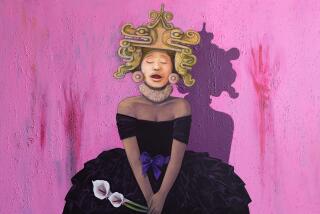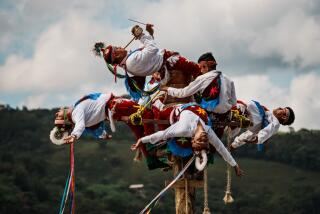In a remote part of the rugged...
In a remote part of the rugged Sierra Madre, in what is now the western Mexican state of Jalisco, the Huichol Indians escaped the attention of Spanish conquerors and Jesuit missionaries until the early 18th Century. Even then, the Huichol held onto their traditions, rituals and beliefs.
Today, about 15,000 Huichol still follow the ways of their ancestors. “Shamans, Pilgrims and Sacred Visions: The Art and Life of Mexico’s Huichol Indians,” an exhibit at Loyola Marymount University’s Laband Art Gallery, is a window to the Huichols’ past and present lives.
The exhibit is the only event of the citywide “Artes De Mexico” festival that focuses on contemporary indigenous peoples of Mexico, said Gordon Fuglie the gallery’s director.
“The Huichol are a people who are committed to living a spiritual journey,” Fuglie said. “For them, the spiritual and natural world are not separate.”
By maintaining a balance within themselves and nature, Fuglie said, the Huichol have developed “an environmentally sound religion and way of life.”
The Huichol grow crops, mainly corn, in the summer and hunt in the winter. In one hunting ritual, Huichol shamans, who serve as priests and medicine men, lead pilgrimages into the desert, said Stacy Schaefer, assistant professor of anthropology at the University of Texas-Pan American and the exhibit’s curator.
During the pilgrimage, the Huichol eat peyote, a hallucinogenic cactus that is neither addictive nor strongly narcotic, Schaefer said. The shamans encourage the pilgrims to communicate directly with the Huichol gods through visions, which the shamans later interpret.
In their daily lives, the Huichol have “practical ecological reasons for doing things, but all their activities are rooted in their religious beliefs,” said Schaefer, who lived among the Huichol for nearly three years.
The Huichol path to wise living requires balancing nature, human life and the spiritual world. But the Huichol fear that the delicate balance is being disturbed. “They believe life in the world is like a candle that is burning really low now,” Schaefer said.
The exhibit features Huichol instruments, embroidered clothing, beaded masks, pottery, yarn paintings and photographs of contemporary Huichol life.
The gallery, located in the university’s Fritz B. Burns Fine Arts Center, is open Wednesday through Friday, 10:30 a.m.-4:30 p.m., and Saturdays, noon to 4 p.m. The Huichol exhibit, which opened Saturday, runs through Dec. 14. Admission is free.
For more information, call the gallery at 338-2880.
More to Read
Sign up for Essential California
The most important California stories and recommendations in your inbox every morning.
You may occasionally receive promotional content from the Los Angeles Times.










